Content Marketing for Small Businesses: 7 Powerful Tips
October 30th, 2024
Reports say there are 1.2 million terabytes of data on the internet (at the very least). This doesn’t include any content that’s not stored on any of the big online storage services or content that’s physical. This means we’re drowning in content, and content marketing is still an important business strategy.
If you’re a small business just starting out, it’ll be challenging to stand out and make your mark in this content-filled world. But it’s not all so doom and gloom. In this guide, we’re diving into the top tips to help you become visible in your content marketing efforts.
Why to do content marketing for small businesses
In any business, you can get leads (and sales) in outbound or inbound approach.
- Outbound: Outbound approaches require you to reach out to prospects.
- Inbound: It means that customers come directly to you, which is possible through content marketing strategies.
As a whole, content marketing, which includes blog posts, social media content, podcasts, and videos, helps:
- Build brand awareness
- Engage with your target audience
- Generate leads on autopilot
These, as we all know, are crucial elements that help sustain and grow any small business.
In an age when AI is being used in digital marketing, content marketers now focus on providing their audiences with higher-quality content that’s easily accessible so they can stand out from the crowd. For this, they:
- Create human-centered narratives in their content.
- Use friendly and humorous language over formal tones.
- Rely on SME insights and complex data to back their claims.
Using text-to-speech (TTS) technology also helps them make content more accessible and engaging. It offers audio versions of blog posts and product descriptions so you can reach audiences who prefer listening over reading. This can also help you reach visually impaired customers and busy individuals who multitask while consuming content.
The end result is that high-quality content gets more mentions and backlinks, hence more visibility, which ultimately drives sales. This makes content marketing an affordable marketing strategy with a strong ROI.
How to get started with content marketing for a small business
Here’s the blueprint for content marketing efforts you can apply to your small business.
Define your target audience
Before we get to the nitty-gritty bits of creating a content strategy plan, we’ll first need to define our target audience, ICPs, and the buying stages we can target them. For reference, most marketers divide the buying stages as ToFu, MoFu, and BoFu.
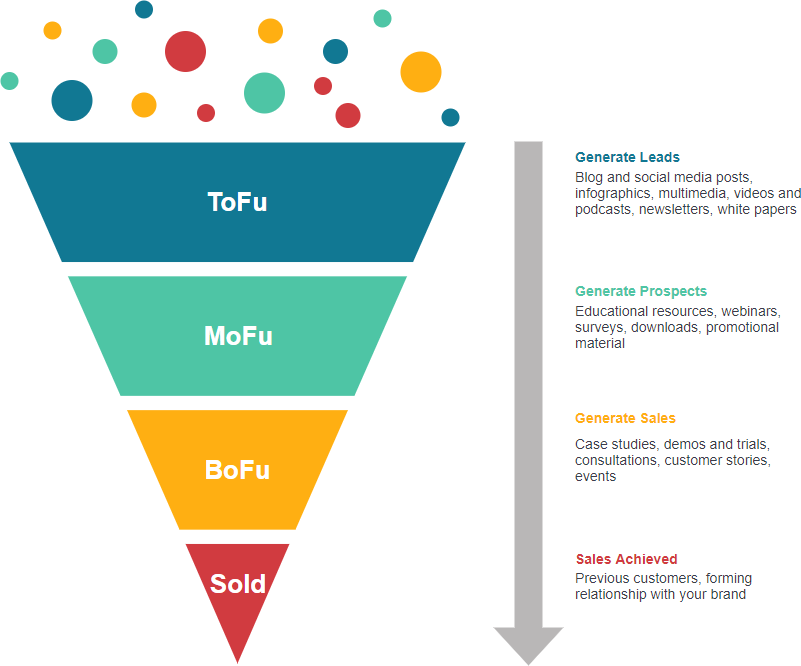
You can customize your content creation strategy by zooming in on your target audience. This ensures it resonates with the needs and expectations of the people who will buy your product or service.
To find your ICPs, you can create buyer personas by listing down the key characteristics of your target audience, such as their:
- Content consumption patterns
- Demographic information
- Psychographic activities
- Income levels
- Pain points
- Challenges
- Motivators
- Location
Create a content strategy
Once you’ve nailed down your target audience, now’s the time to create a content strategy—this includes identifying:
- The content types you are going to produce
- The amount of money you are going to invest in content marketing
- The distribution channels you’re going to target
- The goals you plan on achieving with your content marketing efforts (i.e., your goal could be to get leads, build awareness, or position yourself as a thought leader, etc. Whatever your goals may be, it’s essential to set clear KPIs to measure your results).
For reference, in the past year, 78% of marketers said they would invest in video marketing. On the other end, 69% of them will invest in owned-media assets (i.e., blogs, newsletters, and websites), and 59% of them are investing in paid media. [Report by Content Marketing Institute]
According to the same report, B2B marketers focused on these distribution channels in 2022 for organic content distribution.
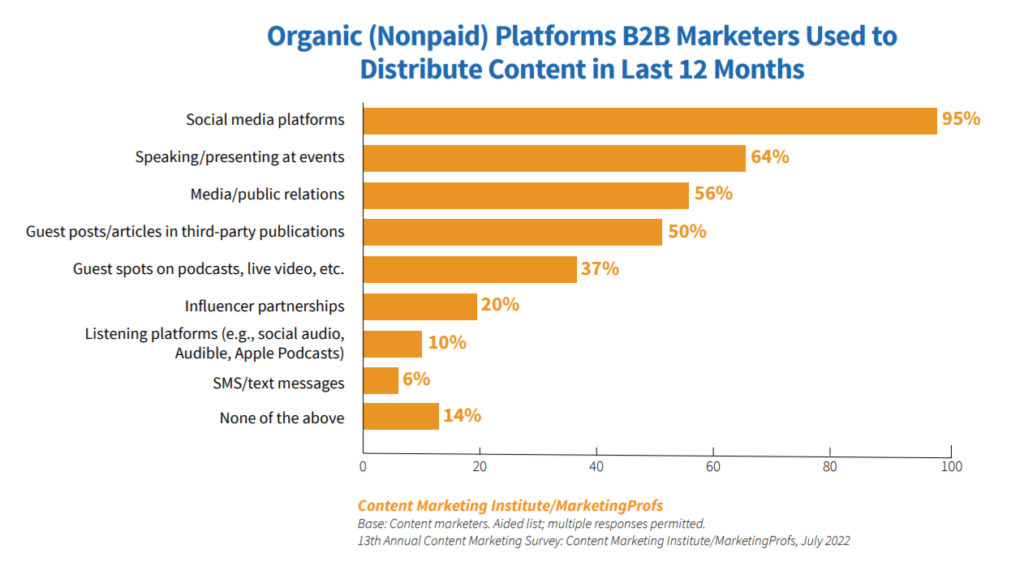
Plan and organize your content calendar
Last but not least, the only thing left to do is to create a content calendar and set it in motion.
These are some of the elements that you can include in your calendar for effective planning and organization:
- Distribution channels
- Status updates on existing pieces
- Post topic
- Visual type
- Link to assets
- Planned list of content activities (or events)
- Link to published post
A content calendar will help you plan and map all your content activities in advance and create a systemized process for you and your team members. This will help you avoid any hiccups or errors later down the line.
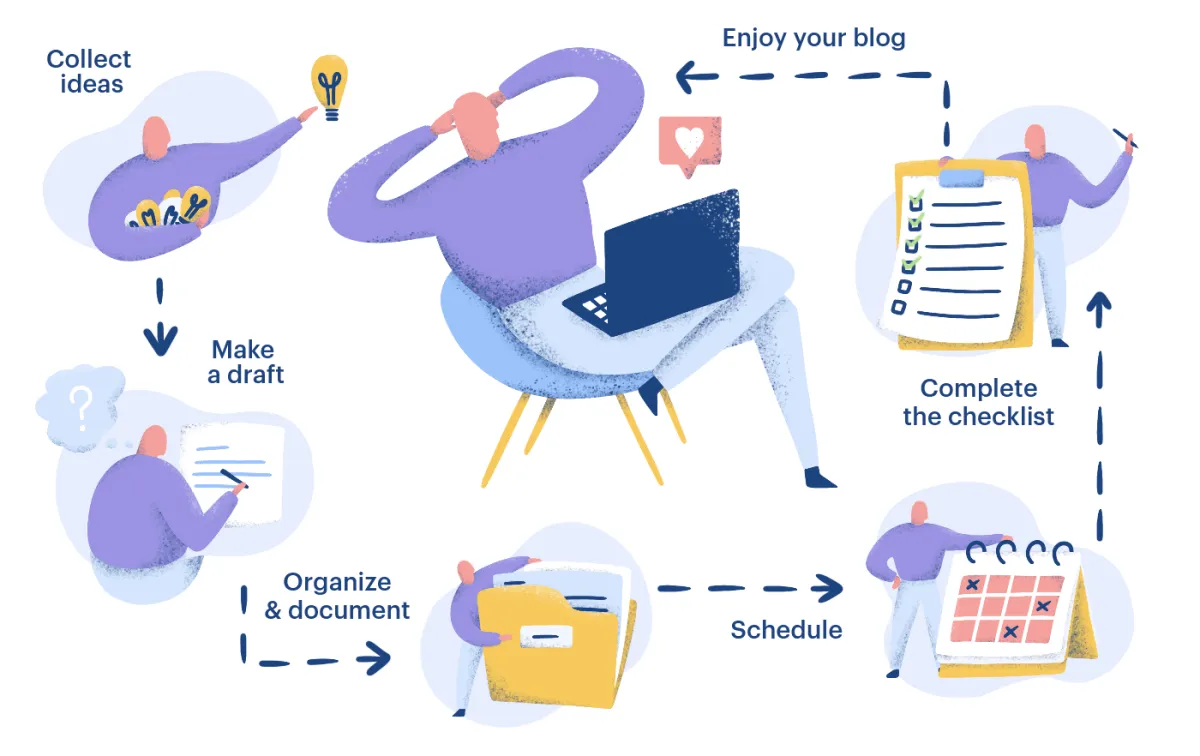
7 content marketing strategy tips for small business
Once you have a content strategy and calendar in place, here are a few ways you can improve your content marketing efforts:
1. Create a blog
While video marketing has recently been on the rise, blog content has always been the darling asset of marketers (and customers alike), which is why we recommend starting a blog.
Here are a few reasons why your blog will always be a compelling marketing channel:
- You can quickly boost your SERP rankings by focusing on search engine optimization (SEO) with blog content.
- Blogs bring in website traffic and educate audiences about your product/service.
- You can build links through informational content and even rely on the audience’s engagement through the comment section.
- Blogs also help build a professional forefront, as almost every established business has its own blog (some businesses even monetize this channel).
If you’re ready to get started creating your blog, you can sign up with Webnode for free. With the help of readymade templates, customizable layouts, and responsive design, blog creation becomes a breeze on Webnode.
On that note, here are some blog strategies you can steal to attain different goals:
- Post educational content
One effective strategy is to regularly post educational content on your blog. This type of content which provides valuable information that addresses your audience’s needs and interests, is crucial for maintaining an engaged audience and improving search engine rankings. This will establish your brand as an authority in your industry and increase organic traffic to your site.
For example, Cruise America, a leading provider of RV rentals in Florida, excels at this strategy. They consistently create laser-targeted content tailored to their audience’s interests across all platforms. This includes travel tips, destination guides, and RV maintenance advice.
- Use social proof to build trust
Use social proof to increase engagement and build trust. For example, if you have an online health publication, include editorial timestamps and statistics and link the information to clinical studies. Ask a medical reviewer (someone with a medical degree) to review your content – This ensures that all medical information is correct and readers or potential clients can trust your brand.
- Create statistics or studies
Consider creating statistics or case studies from your niche to generate natural backlinks by offering a great resource page.
2. Choose the right social media channel(s)
In 2022, here are the top social media channels marketers focused on:
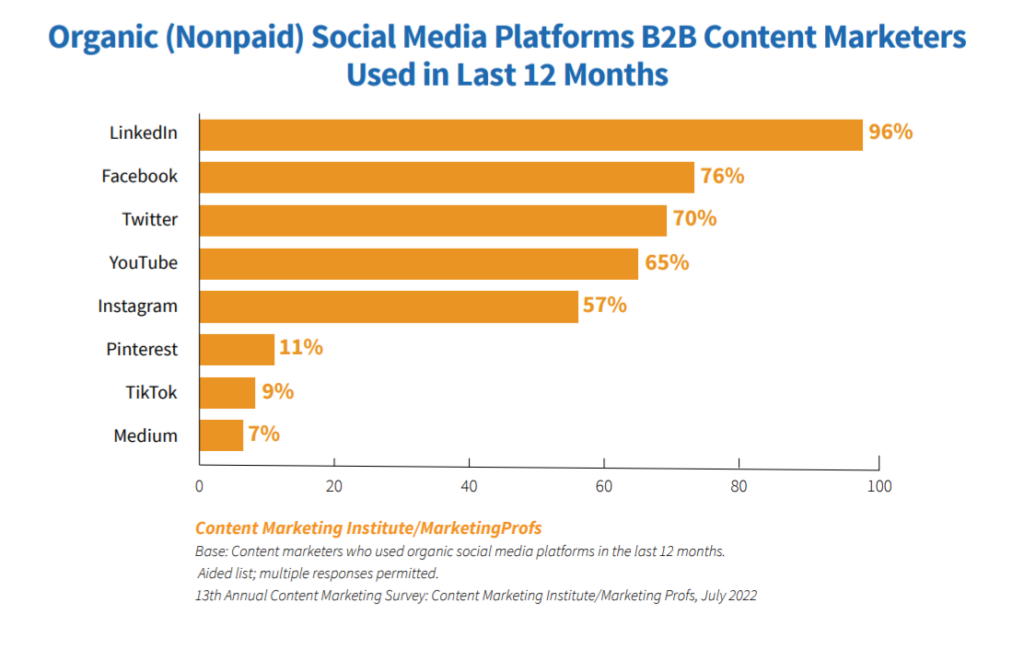
However, the proper social media channels for you will differ based on where your customers are and the content formats/topics they interact with.
To finalize the right social media channel(s) for your business, consider the following questions:
- Which channels see the most traffic, especially for your niche?
- What are your business goals?
- What are your potential clients looking for in your brand?
- What benefits and drawbacks does each social media channel have?
- Which channel do your competitors use?
If you’re using multiple social media channels, it’s best to craft a targeted strategy for different channels to ensure platform nativity and maximize audience connection.
3. Create visually appealing content
Would you rather watch a movie in 144p or 4k HD? Chances are, your answer is 4k HD.
Your readers feel the same. They appreciate quality visuals just like you do. To make your content shine, use visuals that add something to your words. Think of images highlighting key points, infographics breaking down tricky concepts, or videos telling a more engaging story.
This will not only help customers understand your content better, but this balance between visuals and text keeps visitors engaged for longer and makes it easier for them to skim through.
4. Leverage storytelling
It’s easier for us to remember stories than marketing messages, which is why storytelling is becoming a hot commodity in content marketing. In fact, studies suggest storytelling has boosted conversion rates by 30%.
Not only do you engage your customers with this practice (and get sales while at it), but you also:
- Showcase customer experiences (through the help of UGC)
- Create a sense of community
- Foster effective partnerships
- Reiterate your brand values
- Build authentic narratives
- Increase user loyalty
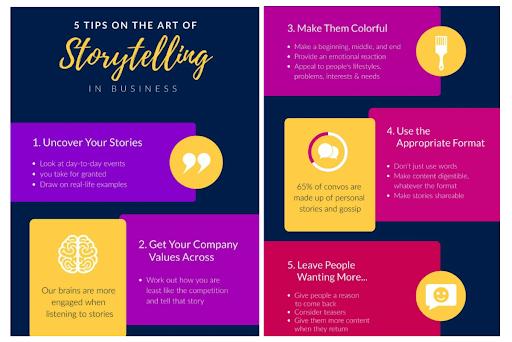
Fellow, an AI meeting management solution company, hosts a podcast with top executives who share insights on their industry, thought patterns, and any challenges they might face at their workplace. Storytelling plays a key role here.
5. Repurpose content
If you’ve gone all in and created valuable content for a particular format, it makes sense to repurpose the same content for different formats so you can reach broader audiences and build awareness. For example, blog content can become social media snippets, videos can become podcast recordings, etc.
6. Use interactive content
Not only is interactive content (like quizzes, calculators, and polls) eye-catching, engaging, and more memorable compared to traditional content forms, but it also helps:
- Build personalized experiences for the end user
- Make it easier to consume customer information
- Differentiate yourself from competitors
- Keep visitors engaged for longer
- Encourage lead generation
All in all, it is a win-win for all parties involved, so it is worthwhile to consider investing in interactive content for your website.
7. Track your results
Last but not least, our final tip would be to track your results and compare them with the KPIs and goals you had in place before you started working on your content marketing strategy.
You can do this by using tools that connect with your website and social media platforms and automatically calculate your visitors, engagement levels, bounce rate, clicks, sales, etc. For example, you can connect your website to tools like Google Analytics to track your results.
Experts suggest regular performance checks, ideally once per week, as this can help identify the most effective content and guide improvements over time.
What will your content strategy look like?
In this article, we discussed the importance of content marketing for small businesses, how to create a blueprint for your content marketing strategy, and some tips that will help you take your content marketing efforts to the next level.
But truth be told, for any content strategy to be effective and successful, you need to deliver a great experience and content to your readers.
Create a blog, start working on your content, and get new customers.
Author Bio:
Kelly Moser is the co-founder and editor at Home & Jet, a digital magazine for the modern era. She’s also an expert in freelance writing and content marketing for SaaS, Fintech, and ecommerce startups.
